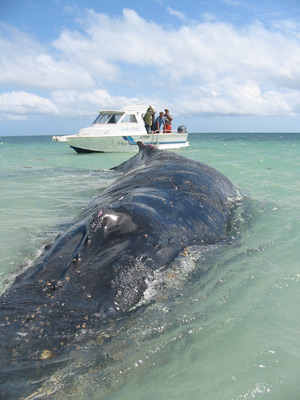Initial explosive charge failed to kill stranded whale

In a sad and gruesome twist, the initial explosive charge set off directly above the brain of a stranded juvenile humpback whale in Western Australia failed to kill the animal. After the whale continued thrashing for several minutes, a wildlife officer began firing several shots into its head, as can be seen in the photo above. After a total of 15 minutes, a second charge was detonated, finally killing the suffering creature. This was really the worst possible outcome of the decision to euthanize this stranded whale. Really, once you’ve made that decision, can there be such a thing as using too many explosives ? I mean, if your plan is to “put it out of its misery,” then why not just plan to blow it to kingdom come? If you think X pounds of explosives is enough, why not just use 5X for good measure? And if the explosives didn’t kill it, why would they then think that shooting it full of bullets for 15 minutes was going to finish the job? The thought processes that lead...


